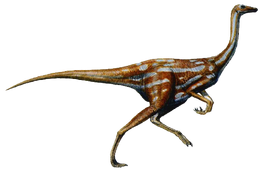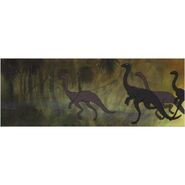Toothless99 (talk | contribs) (Created page with "Ornithomimus was part of the family of ostrich-like dinosaurs. It name means 'bird mimic'. Other members of this family include Gallimimus and Struthiomimus. They are charact…") |
Dinosaurs20 (talk | contribs) (Adding categories) |
||
| (14 intermediate revisions by 10 users not shown) | |||
| Line 1: | Line 1: | ||
| + | [[File:Ornithomimus-dinosaur.png|thumb|264px]] |
||
| − | Ornithomimus was part of the family of ostrich-like dinosaurs. It name means 'bird mimic'. Other members of this family include [[Gallimimus]] and Struthiomimus. They are characterised by long, running legs, a fairly long neck and a beak. Ornithomimus was no exception. |
||
| + | '''Ornithomimus''' (pron.: /ˌɔrnɨθɵˈmaɪməs/; "bird mimic") is a genus of ornithomimid dinosaur from the Late Cretaceous Period (70-66 mya) of what is now North America. |
||
| − | ==Fact File== |
||
| − | Length: 4 metres |
||
| + | In 1890 Ornithomimus velox was named by Othniel Charles Marsh on the basis of a foot and partial hand from the Maastrichtian Denver Formation. Another seventeen species have been named since. Most of these have subsequently been assigned to new genera or shown to be not directly related to Ornithomimus. The best material of species still considered part of the genus has been found in Canada, representing the earlier Edmontonian-age Ornithomimus edmontonicus Sternberg 1933, known from several skeletons. However, on some of these the new genus Dromiceiomimus including Dromiceiomimus brevitertius (Parks 1926) has been based, causing taxonomic problems of priority and identity that are still unresolved. |
||
| − | Height: 2.5 metres |
||
| + | Ornithomimus was a swift bipedal animal covered in feathers, and was equipped with a small toothless beaked head, that may indicate an omnivorous diet. |
||
| − | Weight: 500kg |
||
| + | ==Description== |
||
| − | Diet: [[Omnivore]] |
||
| + | Like other ornithomimids, Ornithomimus is characterized by a foot with three weight-bearing toes, long slender arms and a long neck with a birdlike, elongated, toothless, beaked skull. It was bipedal and superficially resembled an ostrich, except for its long tail. It would have been a swift runner. It had very long limbs, hollow bones, and a large brain and eyes. The brains of ornithomimids were large for dinosaurs, but this may not necessarily be a sign of greater intelligence; some paleontologists think that the enlarged portions of the brain were dedicated to kinesthetic coordination. Their hands are remarkably sloth-like in appearance, which led Henry Fairfield Osborn to suggest that they were used to hook branches during feeding. |
||
| − | ==Prey== |
||
| + | Ornithomimus differs from other ornithomimids, such as Struthiomimus, in having a short back, long slender forearms, very slender, straight hand and foot claws and in having metacarpals and fingers of similar lengths. |
||
| − | Though classed as a theropod, a meat-eating dinosaur, Ornithomimus was probably an omnivore. It would have eaten plants, eggs, insects and meat, depending on what was available. To avoid becoming a meal for dinosaurs like T-Rex, it could run very fast, and would have lived in groups so they could stay alert. |
||
| + | |||
| − | ==Popular Culture== |
||
| + | The three Ornithomimus species today seen as possibly valid, differ rather in size. In 2010 Gregory S. Paul estimated the length of O. edmontonicus at 3.8 metres, its weight at 170 kilograms (370 lb). One of its specimens, CMN 12228, preserves a femur (thigh bone) 46.8 centimetres (18.4 in) long. O. sedens was by Paul estimated at 4.8 metres and 350 kilograms (770 lb). O. velox, the type species of Ornithomimus, is based on material of a much smaller animal. Whereas the holotype of O. edmontonicus, CMN 8632, preserves a second metacarpal 84 millimetres long, the same element with O. velox measures only 53 millimetres. |
||
| ⚫ | |||
| + | |||
| + | ===Feathers=== |
||
| + | In 1996, 2008 and 2009, three Ornithomimus edmontonicus specimens, two adults and a juvenile, were found with remains of pennaceous feather shafts on the lower arm or with impressions of up to five centimetres long primitive feathers in the form of hair-like filaments covering the rump, legs and neck. The fact that the feather imprints were found in sandstone, previously thought to not be able to support such impressions, gives new possibilities for future feather finds. A study describing these fossils in 2012 concluded that O. edmontonicus was covered in plumaceous feathers at all growth stages, and that only adults had pennaceous wing-like structures, suggesting that wings may have evolved for mating displays. |
||
| + | |||
| + | ==In the Media== |
||
| ⚫ | |||
| + | *It also appeared in Fantasia's [[The Rite of Spring]]. |
||
| + | *Ornithomimus appears in the animated series, [[Dinosaur Train]]. |
||
| + | *It also appears in [[Jurassic World: Alive]]. |
||
| + | |||
| + | ==Gallery== |
||
| + | <gallery> |
||
| + | Illustration of Ornithomimus velox.png |
||
| + | Reconstruction of Ornithomimus edmontonicus size.png |
||
| + | Ornitho cel.jpg |
||
| + | </gallery> |
||
| + | |||
| ⚫ | |||
[[Category:Dinosaurs]] |
[[Category:Dinosaurs]] |
||
| ⚫ | |||
[[Category:Theropods]] |
[[Category:Theropods]] |
||
| + | [[Category:Ornithomimids]] |
||
| + | [[Category:Omnivores]] |
||
[[Category:Cretaceous]] |
[[Category:Cretaceous]] |
||
[[Category:Dinosaurs of North America]] |
[[Category:Dinosaurs of North America]] |
||
| + | [[Category:Herbivores]] |
||
| + | [[Category:Dinosaur Train Dinosaurs]] |
||
| + | [[Category:Fossil taxa described in 1890]] |
||
Latest revision as of 22:39, 22 July 2023

Ornithomimus (pron.: /ˌɔrnɨθɵˈmaɪməs/; "bird mimic") is a genus of ornithomimid dinosaur from the Late Cretaceous Period (70-66 mya) of what is now North America.
In 1890 Ornithomimus velox was named by Othniel Charles Marsh on the basis of a foot and partial hand from the Maastrichtian Denver Formation. Another seventeen species have been named since. Most of these have subsequently been assigned to new genera or shown to be not directly related to Ornithomimus. The best material of species still considered part of the genus has been found in Canada, representing the earlier Edmontonian-age Ornithomimus edmontonicus Sternberg 1933, known from several skeletons. However, on some of these the new genus Dromiceiomimus including Dromiceiomimus brevitertius (Parks 1926) has been based, causing taxonomic problems of priority and identity that are still unresolved.
Ornithomimus was a swift bipedal animal covered in feathers, and was equipped with a small toothless beaked head, that may indicate an omnivorous diet.
Description
Like other ornithomimids, Ornithomimus is characterized by a foot with three weight-bearing toes, long slender arms and a long neck with a birdlike, elongated, toothless, beaked skull. It was bipedal and superficially resembled an ostrich, except for its long tail. It would have been a swift runner. It had very long limbs, hollow bones, and a large brain and eyes. The brains of ornithomimids were large for dinosaurs, but this may not necessarily be a sign of greater intelligence; some paleontologists think that the enlarged portions of the brain were dedicated to kinesthetic coordination. Their hands are remarkably sloth-like in appearance, which led Henry Fairfield Osborn to suggest that they were used to hook branches during feeding. Ornithomimus differs from other ornithomimids, such as Struthiomimus, in having a short back, long slender forearms, very slender, straight hand and foot claws and in having metacarpals and fingers of similar lengths.
The three Ornithomimus species today seen as possibly valid, differ rather in size. In 2010 Gregory S. Paul estimated the length of O. edmontonicus at 3.8 metres, its weight at 170 kilograms (370 lb). One of its specimens, CMN 12228, preserves a femur (thigh bone) 46.8 centimetres (18.4 in) long. O. sedens was by Paul estimated at 4.8 metres and 350 kilograms (770 lb). O. velox, the type species of Ornithomimus, is based on material of a much smaller animal. Whereas the holotype of O. edmontonicus, CMN 8632, preserves a second metacarpal 84 millimetres long, the same element with O. velox measures only 53 millimetres.
Feathers
In 1996, 2008 and 2009, three Ornithomimus edmontonicus specimens, two adults and a juvenile, were found with remains of pennaceous feather shafts on the lower arm or with impressions of up to five centimetres long primitive feathers in the form of hair-like filaments covering the rump, legs and neck. The fact that the feather imprints were found in sandstone, previously thought to not be able to support such impressions, gives new possibilities for future feather finds. A study describing these fossils in 2012 concluded that O. edmontonicus was covered in plumaceous feathers at all growth stages, and that only adults had pennaceous wing-like structures, suggesting that wings may have evolved for mating displays.
In the Media
- Ornithomimus was featured in the TV series Prehistoric Park.
- It also appeared in Fantasia's The Rite of Spring.
- Ornithomimus appears in the animated series, Dinosaur Train.
- It also appears in Jurassic World: Alive.


